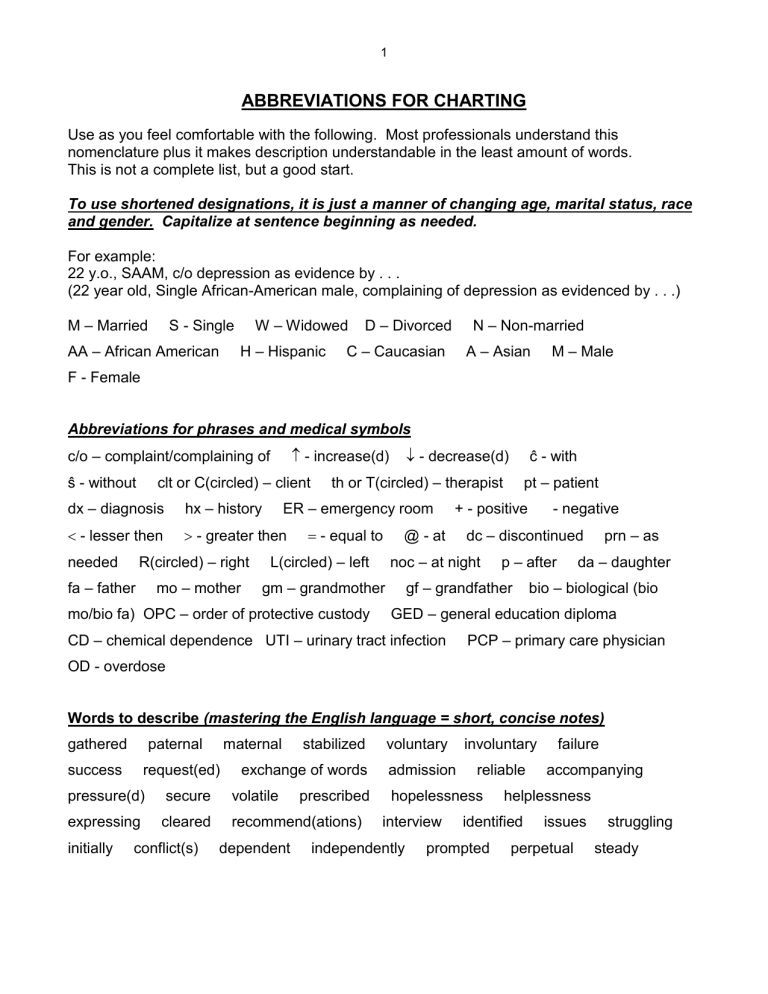
1 ABBREVIATIONS FOR CHARTING Use as you feel comfortable with the following. Most professionals understand this nomenclature plus it makes description understandable in the least amount of words. This is not a complete list, but a good start. To use shortened designations, it is just a manner of changing age, marital status, race and gender. Capitalize at sentence beginning as needed. For example: 22 y.o., SAAM, c/o depression as evidence by . . . (22 year old, Single African-American male, complaining of depression as evidenced by . . .) M – Married W – Widowed S - Single AA – African American H – Hispanic D – Divorced N – Non-married C – Caucasian A – Asian M – Male F - Female Abbreviations for phrases and medical symbols - increase(d) c/o – complaint/complaining of ŝ - without clt or C(circled) – client dx – diagnosis hx – history - lesser then - greater then R(circled) – right needed fa – father mo – mother - decrease(d) ĉ - with th or T(circled) – therapist ER – emergency room - equal to L(circled) – left mo/bio fa) OPC – order of protective custody + - positive @ - at - negative dc – discontinued noc – at night gm – grandmother pt – patient p – after gf – grandfather prn – as da – daughter bio – biological (bio GED – general education diploma CD – chemical dependence UTI – urinary tract infection PCP – primary care physician OD - overdose Words to describe (mastering the English language = short, concise notes) gathered paternal success maternal request(ed) stabilized exchange of words pressure(d) secure volatile expressing cleared recommend(ations) initially conflict(s) dependent prescribed voluntary admission involuntary reliable hopelessness interview independently accompanying helplessness identified prompted failure issues perpetual struggling steady 2 relationship facility role model father/mother figure process further exploration sporadic psychopathology high grade oscillating overlapping side effects pathology describe otherwise perpetrator disheveled irritability disappointed manage dynamics manifested precaution(s) resolution delusions recommendations revisit substantial recreation(al) allergic extremely judgment insight chronic limited support system self-destructive criteria adamantly voices . . . supportive alert oriented goal directed irritable suicidal acute status legal restricted nervous logical remedy(ies) illicit reaction(s) congruent discrete numerous restructure(ing) anxious potential low grade With regards to . . . presents psychiatric episode(s) outbursts trauma intelligent behavior solution(s) admits infidelity constant psychosis compulsive spontaneous coherent hallucinations denies as mentioned self-harm articulate endorse abuse significant noncontributory affect desire impulsive prescription(s) contributory mood quality attempt(ed) victim misuse substantial function(ing) homicidal intention motivated(ion) resistant exacerbates appropriate compliant(ance) safety structure opportunity stability substantiate tolerate(s) *********************************************************************************************************** Writing SOAP Notes (taken (with additions) from Learning to Write Case Notes Using the SOAP Format –Susan Cameron and Imani turtle-song) SOAP notes were developed in 1964 by L.L.Weed to enhance continuity of client care and assist in better recall/communication of details between and for the healthcare professional. Other case notes that are variations of the SOAP note model include: DAP – Data, Assessment, Plan FOR – Functional Outcomes Reporting Using the SOAP Format The four components of SOAP notes are: (S) subjective (O) objective (A) assessment (P) plan S – Subjective information about the presenting problem from the client’s perspective. O – Objective information observed by the counselor. 3 A – Assessment that demonstrates how the S and O data is formulated/interpreted/reflected upon. P – plan summarizing of the direction of treatment. Subjective This section can be the most troublesome. Here the client’s feelings, goals and thoughts as well as the intensity of the problem and how it may affect significant other(s) are recorded. The entry should be as brief and concise as possible without the overuse of quotations since at the end of a session, research shows that it is unlikely to accurately remember verbatim information. If, however quotations are used, only key words or phrases should be recorded. For example, this might include a suicidal or homicidal ideation, unwillingness to provide necessary information, inappropriately aggressive or abusive language that the counselor may deem threatening. For instance, a father accused of shaking his 6-month-old daughter when she would not stop crying says, “I only scared her when I shook her, I didn’t hurt her.” The counselor might write: “Minimizes the effects of shaking infant daughter. States, “I only scared her.” Use only a minimum of quotes Ways to write briefly, yet concisely: The client may say, “Therapy is really helping me put my life into perspective,” (10 words), could be written “Reports therapy is really helping.” (Five words) Rather than using names of specific people’s names, use general terms as “fellow employee” or “mental health worker”, and briefly report the themes of the client’s complaint. The content of the S section belong to the client. For brevity’s sakes, the counselor should write, “reports, states, says, describes, indicates, complains of. For example, instead of writing, “Today the client says, ‘I am experiencing much more marital trouble since the time before our last session’ (14 words), the counselor might write, “Client reports increased marital problem since last session.” (8 words). Objective This information should be factual and in quantifiable terms – that which can be seen, heard, smelled, counted or measured. Avoid words such as “appeared” or “seemed” without objective supporting evidence. Avoid labels, personal judgments, opinionated statements. Words that carry a negative connotation such as, “uncooperative”, “manipulative,” “abusive,” “obnoxious,” “spoiled,” “dysfunctional,” and “drunk.” These words are open to personal interpretation. The most helpful phrase is, “as evidenced by.” 4 For example, “Appeared depressed, as evidenced by significantly less verbal exchange; intermittent difficulty tracking. Hair uncombed, clothes unkept. Denies feeling depressed.” Simply record what is seen, heard, or smelled. For example, “Client smelled of alcohol; speech slow and deliberate in nature; uncontrollable giggles even after stumbling against door jam; unsteady gait.” Assessment This section summarizes the counselor’s clinical thinking. Clinical impressions may also be used to “rule out” or “rule in” a diagnosis. Clinical impressions also enable viewers to follow the counselor’s reasoning and direction for treatment. When making a diagnostic impression, ask the question, “Is there adequate/sufficient data here to support a clinical diagnosis?” If sufficient data has been collected, the S and O sections should reasonably support the diagnosis. If, however, there is ambivalence in making a diagnosis this might suggest insufficient data has been collected or that a consultation with a senior colleague is in order. Plan This section describes the parameters of the intervention. It consists generally of two parts, the action plan and the prognosis. It may include a referral to an agency or some other form of intervention. The prognosis is a forecast of the probable gains to be made by the plan. Scenario Cecil is a 34-year-old man mandated by the courts to obtain counseling to resolve his problems with domestic violence. He comes into the office, slams the door, and announces in a loud and irritated voice, “This counseling stuff is crap! There’s no parking! My wife and kids are gone! And I got to pay for something that don’t work!” Through most of the counseling session, Cecil remains agitated. Speaking in an angry and aggressive voice, he tells you that his probation officer told him he was a good man and could get his wife and kids back. He demands to know why you are not really helping him get back what is the most important to him. He insists that, “Mary just screws everything up?” He goes on to tell you of a violent argument he and Mary had last night regarding the privileges of their daughter Nicole, who just turned 16. You are aware that there is a restraining order against Cecil. During the session, you learn Cecil was raised in a physically and verbally abuse family until he was 11, at which time he was placed in protective custody by social services, where he remained until he was18. He goes on to tell you that he has been arrested numerous times for “brawling” and reports that sometimes the littlest things make him angry and he just explodes, hitting whatever is available – the walls, his wife, the kids, and three guys at work. Cecil also reports prior arrests for domestic violence. He admits that at various time, he has been both 5 physical and emotionally abusive to Mary and the children but insists that it was needed to “straighten them out.” Just before leaving your office, Cecil rushes from his chair and stands within a foot of you. Angrily, with his fist and jaw clenched, he says, “This is the same old B.S. You guys are just all talk.” He storms from the room. Sample SOAP note (using abbreviations and meanings not put in above notes) S: Reports cslng (counseling) not helpful in getting family back. Insists on violence to “straighten out” family. Reports hx (history) of DV (Domestic violence). States verbally fought ĉ (with) wife over oldest child’s privileges. Clt. or C (circled) reported personal physical and mental abuse as child resulting foster care placement, ages 8-11. O: Generally agitated in session as evidenced by clenched fist and jaw. Near end of session, clt or C(circled) stated counseling is “same old B.S!” Rushed out of office. A: Physical abuse as adult and child. P: Prognosis guarded due to (decreases or low) level of motivation to change. Will continue __________therapy. Possible referral to Dr. ___________ for psych. (psychiatric) eval.(evaluation) and Men’s Alternative Violence Group. Next session, introduce use of “time outs.”

